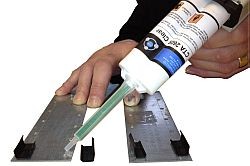At full right lock, the tie-rod is parallel to the hub arm
but the edge of the hub fouls the rose-joint during full-droop
so I grinded the hub edge to provide better clearances
Full right lock when drooped. notice this is swinging the rose-joint at it's angular limit
Full left lock when drooped
-- Bump steer during full lock --
Now lets check the bump steer during full lock.
When the inside wheel is fully drooped, it turns in slighter tighter. may help pull the front end during hard low-speed tight turns
When the inside wheel is fully compressed, it turns abit less
When the outside wheel is fully drooped, it's still straight
When the outside wheel is fully compressed, it turns slightly less.
about the same amount as if the inside wheel was also fully compressed such as very hard braking at full lock.
but when the body leans over during cornering, the drooping inside wheel actually turns more to help the outside wheel.
-- Finish Right Hand Suspension --
Fitted the rubber boot on the rose joint, which was kind of a tricky stretch, looks neat
RH rose joint finally finished
At full right lock & fully drooped, the steering tie-rod barely misses the chassis and the swaybar
RH coilover cover is abit damaged so just wrapped it in ducktape for the moment
And that's the ball joint extension & bump-steer corrected tie-rod ends finished on the right side


 -- Finish LH Suspension --
-- Finish LH Suspension --
Machined the LH rose joint
it welded better than my first one
booted up
and installed
-- Replace SRS Airbag Steering Wheel --
And now to replace my old worn steering wheel.
Notice on my preface 1998 system (right), the airbag controller is fitted inside the steering wheel.
whereas on the replacement 2001 facelift (left) the airbag controller will be fitted at the bottom of the dash console just in front of the ECU and the steering wheel has a blanking plate.
The rubber grip on the preface old wheel has this slimmer profile to it whereas the facelift wheel has this beefy chunky full-round profile, which will change the ergonomic weight & feel of the steering
Removing & swapping the airbag controller over
The core structure of a steering wheel
Here's another difference in the horn switch.
on the preface airbag wheel, the wire that goes to the airbag/horn controller box is riveted to the contact bracket.
on the facelift airbag wheel, there's just a spade connecter, similar to a preface non-airbag wheel.
Wiped the wheel with carb cleaner to get rid of previous human slime
 -- Initial Test Drive --
-- Initial Test Drive --
Aligned the steering by eye in the dark night (got it pretty close but will correct the toe tomorrow) and very excitedly eager to get on with taking her for a test drive tonight.
Initially vigorously wiggled, shaked and yanked the steering around while during down the street to check everything is tight and solid.
Drove up to the usual countryside and motorway and Oh My Friggin Jezuz mighty Gawd kasandra's steering & handling is completely utterly transformed for the better



The vague dead-zone in the middle is almost eliminated, I wiggle the steering and it immediately responds. if I wiggle at high-speed, the rear end feels very floppy & slow reacting from the full soft damper setting.
When I turn into a corner, Bang! her front end instantly shoots in that direction with zero delay
(the loaded up outer suspension arm would be perfectly horizontal and instantly ready to transfer lateral forces from the hub straight into the chassis rather than wasting time trying to roll the chassis & compress the springs in the old wrong geometry).
Throughout the corner she just keeps on turning very positively and stable with minimal understeer, even on some roundabouts and countryside bends where she used to struggle. no matter how much steering and speed I dared her to goto, she just turns and I can feel the soft rear end almost struggling to keep up.
Over straight & cornering bumps, she just always feels so calm & composed. corrected bump-steer working very nicely.
She feels amazingly perky & very lively

I'm gonna have to relearn her handling behavior, where her limit is and how much I can trust her



